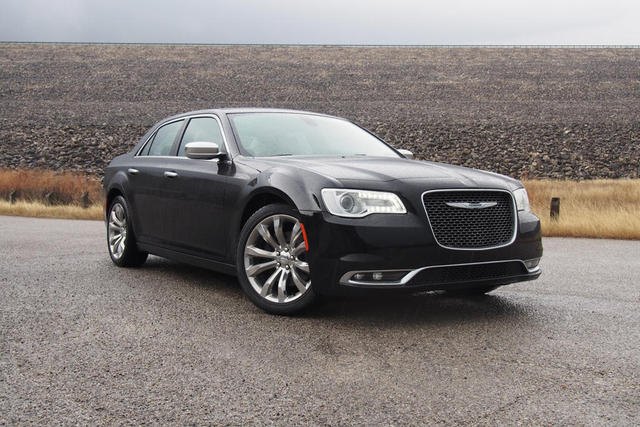Capsule Review: 2015 Chrysler 300
25 years ago, every American automaker offered at least one vehicle that fit what Kim Clark and Takahiro Fujimoto called “the American Plan”: body-on-frame construction, rear-wheel-drive, V8 power, and a roughly 120-inch wheelbase. This was in stark contrast to the increasingly popular offerings from offshore, which were the antithesis of the American Plan. Today, no American automaker offers such a product.
The modern family car has abandoned the American plan in favor of the transverse, front-drive layout that was once the exclusive province of compact and subcompact cars. Chrysler’s dependence on the K platform meant that they were committed to such a change early in the game. They were also arguably the first of the Big Three to abandon the American Plan when their M-Body cars died in 1989. Today, however, they are the only ones that offer anything close to it.
Allow me to pre-empt cries of “BIAS!” from fans of the bowtie brand. The Chevrolet SS, as enticing as it is, is an ultra-low-volume specialty car meant to compete with high-zoot versions of the Dodge Charger. In another life, GM may have introduced a Zeta-based Impala. But that dream died along with Lehman Brothers. The LX cars, meanwhile, have soldiered on, getting progressively better with age. Not long ago, Jack had good things to say about a rental 2014 model with the V6/8-speed combo. As of about now, that version is obsolete.
New for 2015 is a larger grille with a prominent Chrysler badge. It recalls the “Bentley grille” aftermarket add-ons that were popular during the 300’s introduction in 2005. There are also slight changes to the lighting and wheel and tire packages and an updated gauge cluster (no ATS-style 80’s dials here). A rotary gear knob also replaces the awkward short-throw shifter that Jack’s 300 employed.
The biggest news for 2015 might be the demise of the SRT versions of the 300 – at least in our market. Certain overseas markets will get a new 300 SRT, since they don’t get the Charger. North American customers who want a hi-po 300 will have to make do with the 300S V8, which features bespoke styling treatments like side skirts and a rear wing, as well as slightly stiffer suspension settings.
But in keeping with TTAC tradition, we made a bee-line for the “base” car, the 300 Limited. Base is a bit of a misnomer, since this version has just about everything one could possibly want in a large sedan. The standard spec sheet reads like a checklist of everything we like about Chrysler products: the 3.6L Pentastar V6, made to an 8-speed automatic transmission, the UConnect 8.4″ touchscreen and the Alpine stereo (which Jack nominated as one of the best in the business), an all-new electric power steering system borrowed from other rear-drive Chrysler products that surpasses the old hydraulic unit.
Opting for the Limited means you can’t get the 363 horsepower Hemi V8 or the 300-horsepower variant of the 3.6L Pentastar V6 – instead, you must settle for a mere 292 horsepower. But the Limited does offer a choice of either rear or all-wheel drive, and a driving experience free of extraneous technology like Lane Departure Warning with Lane Keep Assist, Forward Collision Warning with Active Braking and Adaptive Cruise Control (which, it must be said, works quite well).
What you do get is a sedan based on a 21st century version of the American Plan. The 120-inch wheelbase makes this an ideal interstate cruiser, though the Charger has a bigger trunk. The Pentastar V6 makes far more power than the V8s of a quarter century ago and the 8-speed transmission (double the number of ratios found in that same era) makes the most of all 292 horsepower and 260 lb-ft of torque. Over mixed driving on the freeways and back roads of Austin, Texas, we saw about 24 mpg, while highway mileage is claimed by FCA to sit at 31 mpg.
For not much more than thirty grand (or less, when you factor in the inevitable cash on the hood, or buying a year-old ex-rental) you can have a proper American sedan that will leave you satisfy in every single way, assuming you never try the V8 version. Chrysler was keen to tout the V8 powered 300S, but I’ll take the regular 300C (the black car in our photos), without any of the sporting pretensions or superfluous body modifications. Where the V6 starts to run out of breath above 80 mph, the 5.7L Hemi keeps on pulling well into the triple digits. The 8-speed is a welcome replacement for the durable but antiquated 5-speed Benz unit.The new EPAS system will be familiar to anyone who has driven a new Jeep Grand Cherokee – the steering is weighted nicely, but doesn’t provide the most lucid feedback, Body motions are well controlled, and the 300 is about as responsive and nimble as you’d expect a two-tonne full-size sedan to be. The lone disappointment are the brakes. The pedal felt soft and lazy, forcing me to press the toe of my Ariat Ropers towards the carpet far quicker than I’d have liked when coming to a halt from high speeds. One could live without most of the performance gear from the SRT versions on a daily basis. The big binders from the 6.4L Charger wouldn’t hurt on the 300.
While the changes to the 300 itself are incremental, what really matters is that Chrysler has finally managed to separate the 300 and Charger into two distinct product lines. The 2015 300 Limited is only $2,000 more than a comparable equipped $29,995 Charger SXT, but the difference in interior quality is significant enough that only the most die-hard skinflint, Dodge brand fanatic or rental car company would consider the Charger as a serious alternative. Of course, there is a base model Charger SE at $27,995, as well as the big block 6.4L and 6.2L SRT Chargers, but that’s the point; Dodge now has Charger options to bookend the 300, whereas before, it was a mish-mash of John Varvatos Luxury Editions and Scat Packs and Super Bees at intersecting price points.The rationalization of the two product lines doesn’t solve the essential question of who the 300 is for. It’s not as sporting as a Cadillac CTS, but sharper than a V6 Hyundai Genesis. It’s bigger, roomier and pricier than a V6 Camcord, but an Impala or an Avalon is probably better for hauling rear seat passengers.But that’s ok. The weird niche that the 300 (and Charger) occupy is what allow it to exist. It has the market sewn up for itself, and nobody has the stones to challenge Chrysler. It’s a formula employed by everything from the Mercedes E-Class Wagon to the Toyota Tacoma to the Mazda MX-5 – niche products that serve a particular customer, and serve it well.
More by Derek Kreindler
Latest Car Reviews
Read moreLatest Product Reviews
Read moreRecent Comments
- MaintenanceCosts What is the actual out-the-door price? Is it lower or higher than that of a G580?
- ToolGuy Supercharger > Turbocharger. (Who said this? Me, because it is the Truth.)I have been thinking of obtaining a newer truck to save on fuel expenses, so this one might be perfect.
- Zerofoo Calling Fisker a "small automaker" is a stretch. Fisker designed the car - Magna actually builds the thing.It would be more accurate to call Fisker a design house.
- ToolGuy Real estate, like cars: One of the keys (and fairly easy to do) is to know which purchase NOT to make. Let's see: 0.43 acre lot within shouting distance of $3-4 million homes. You paid $21.8M in 2021, but want me to pay $35M now? No, thank you. (The buyer who got it for $8.5M in 2020, different story, maybe possibly.) [Property taxes plus insurance equals $35K per month? I'm out right there lol.] Point being, you can do better for that money. (At least the schools are good? Nope lol.)If I bought a car company, I would want to buy Honda. Because other automakers have to get up and go to work to make things happen, but Honda can just nap away because they have the Power of Dreams working for them. They can just rest easy and coast to greatness. Shhhh don't wake them. Also don't alert their customers lol.
- Kwik_Shift_Pro4X Much nicer vehicles to choose from for those coins.




















































Comments
Join the conversation
I think this whole "Gee what segment does this fit in? Who is going to buy it? It doesn't fit!!!" argument is so tired. It's a big American* sedan with brash looks, a nice interior, and lots of power. For like 30 grand. So people who prefer a big squishy 'murica yacht for 30k have one choice, and aren't really punished for choosing it.
Like how they are leaving the Nascar engines to Dodge. Hopped up, gaudily appointed "luxury" cars (that'd be AMG S) always struck me as about as flattering as a toupee with 80s era highlights.